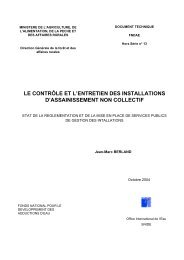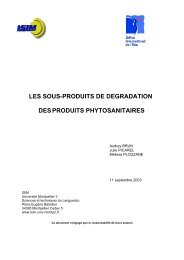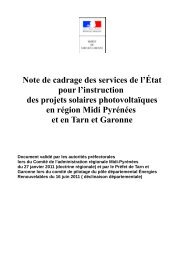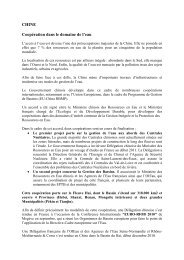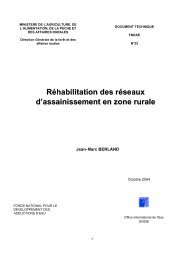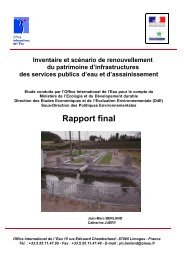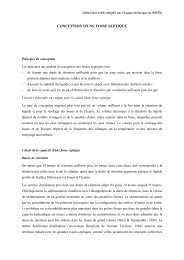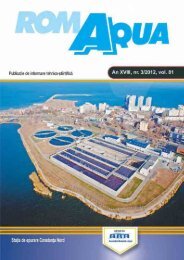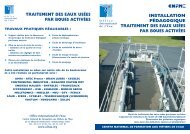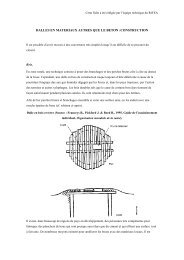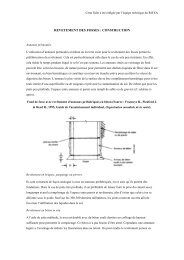vol 77 n° 5 2011 - Office International de l'Eau
vol 77 n° 5 2011 - Office International de l'Eau
vol 77 n° 5 2011 - Office International de l'Eau
Create successful ePaper yourself
Turn your PDF publications into a flip-book with our unique Google optimized e-Paper software.
STUDII SI CERCETARI<br />
socio-political reception of sewage sludge recycling<br />
A comparison of water service<br />
charges as a proportion of net personal<br />
income with consumption<br />
per head, however, showed that<br />
increasing family income does not<br />
reduce average consumption below<br />
80 l/person/day. This relation is<br />
shown in figure 1.<br />
In the 10 years since these statistics<br />
were produced, a new phenomenon<br />
has ma<strong>de</strong> its appearance<br />
– non-payment of water charges.<br />
We will return to this issue later.<br />
The steady tightening of wastewater<br />
treatment emission levels<br />
has mainly in<strong>vol</strong>ved the nitrogen<br />
and phosphorus nutrients.<br />
In response,<br />
there have been improvements<br />
in the efficiency<br />
of wastewater<br />
treatment technology,<br />
causing an increase in<br />
the unit costs of sludge.<br />
The costs of treating<br />
communal sludge<br />
in Hungary vary between<br />
€20 and 40 (<strong>de</strong>watered<br />
sludge with 18-25% dry<br />
matter content). This inclu<strong>de</strong>s the<br />
cost of removal and treatment of<br />
the sludge, but not the costs of<br />
handling it within the wastewater<br />
treatment plants.<br />
2.<br />
Aspects peculiar<br />
to Hungary<br />
Hungary’s wastewater system<br />
has <strong>de</strong>veloped very rapidly in recent<br />
years. This shows up very<br />
clearly from the 31% increase in<br />
the number of households connected<br />
to the drainage system in<br />
the last twenty years. Starting from<br />
41% in 1990, it has reached 72% in<br />
2010, fulfilling the European Union<br />
requirement for every system to<br />
terminate in a wastewater works<br />
providing at least biological treatment.<br />
[3]<br />
The construction of the necessary<br />
wastewater systems and treatment<br />
works was given a powerful<br />
boost by support from both EU<br />
and government funds. Towns<br />
and villages in Hungary are spread<br />
across a relatively wi<strong>de</strong> population<br />
spectrum. Budapest stands well<br />
table 1: Distribution of Hungarian population by<br />
size of town [4]<br />
apart, and is followed by four<br />
large cities. Villages with less than<br />
2000 inhabitants are very numerous<br />
but account for only 17% of<br />
the country’s population. [4]<br />
Owing to the low population <strong>de</strong>nsity<br />
in such villages, unit drainage<br />
costs are very high. At the same<br />
time, the municipalities can only<br />
turn for support to national funding,<br />
which results in the choice<br />
of local treatment solutions, without<br />
a wastewater drainage system.<br />
Regulation of these treatment<br />
solutions is a current task at national<br />
level.<br />
The EU-supported objectives<br />
of the National Wastewater Programme<br />
for 2015 are:<br />
- By the end of 2015, level II<br />
(biological) sewage treatment must<br />
be provi<strong>de</strong>d in conurbations of<br />
between 10,000 and 15,000 PE, and<br />
by this time at the latest in conurbations<br />
of 2000-10,000 PE.<br />
- By the end of 2015, artificial<br />
biological or equivalent treatment<br />
works must be set up in every<br />
wastewater drainage agglomeration<br />
smaller than 2000 PE which<br />
lies in a <strong>de</strong>signated hydrogeologically-sensitive<br />
area.<br />
The places where these <strong>de</strong>velopments<br />
have to be completed<br />
thus face crucial choices of sewage-treatment<br />
and sludge-management<br />
technology in the next five<br />
years.<br />
3. Changing<br />
reception of<br />
sludge-management<br />
options<br />
There have been major changes<br />
recently in processes and machinery<br />
for <strong>de</strong>watering sludge. Processes<br />
which were difficult to operate<br />
or required much labour, such<br />
as sludge beds or simply spreading<br />
wet sludge on to agricultural land,<br />
have given way to mechanised technologies<br />
with high energy-consumption.<br />
Improvements in <strong>de</strong>watering<br />
technology have achieved<br />
higher and higher levels of dry<br />
matter content, reducing the costs<br />
nr.5 / <strong>2011</strong> www.romaqua.ro<br />
21



